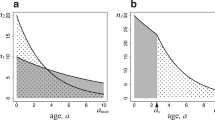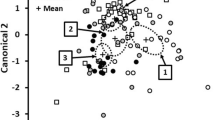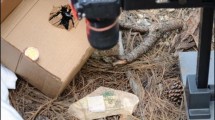Abstract
We briefly review the literature on the division of labour in ant colonies with monomorphic worker populations, and show that there are anomalies in current theories and in the interpretation of existing data sets. Most ant colonies are likely to be in unstable situations and therefore we doubt if an age-based division of labour can be sufficiently flexible. We present data for a type of small ant colony in a highly seasonal environment, concentrating on individually marked older workers. We show that contrary to expectation such workers undertake a wide variety of tasks and can even retain their ability to reproduce, even whilst younger workers are actively foraging. Our analysis shows that old workers occupy four distinct spatial stations within the nest and that these are related to the tasks they perform. We suggest that correlations between age and task in many ant colonies might simply be based on ants foraging for work, i.e. actively seeking tasks to perform and remaining faithful to these as long as they are profitably employed. For this reason, employed older workers effectively displace unemployed younger workers into other tasks. In a companion paper, Tofts 1993,Bull. math. Biol. develops an algorithm that shows how foraging for work can be an efficient and flexible mechanism for the division of labour in social insects. The algorithm creates a correlation between age and task purely as a by-product of itsmodus operandi.
Similar content being viewed by others
Literature
Bourke, A. F. G. 1988. Worker reproduction in the higher eusocial Hymenoptera.Q. Rev. Biol. 63, 291–311.
Calabi, P. 1988. Behavioral flexibility in Hymenoptera: a reexamination of the concept of caste. InAdvances in Myremcology, J. C. Trager (Ed.). Leiden: Brill Press.
Calabi, P. and J. F. A. Traniello. 1989. Social organization in the antPheidole dentata: Physical and temporal caste ratios lack ecological correlates.Behav. Ecol. Sociobiol. 24, 69–78.
Camazine, S. 1990. Pattern formation on the combs of honey bee colonies: self-organization based on simple behavioural rules. InSocial Insects and the Environment, G. K. Veeresh, K. Mallik, C. A. Viraktamath (Eds), 11th International Congress IUSSI 1990, pp. 527–528. New Delhi, India: India Oxford and IBH.
Camazine, S. 1991. Self-organizing pattern formation on the combs of honey bee colonies.Behav. Ecol. Sociobiol. 28, 61–76.
Camazine, S., J. Sneyed, M. J. Jenkins and J. D. Murray. 1990. A mathematical model of self-organized pattern formation on the combs of honeybee Colonies.J. theor. Biol. 147, 553–571.
Clark, P. J. and F. C. Evans. 1954. Distance to nearest neighbour as a measure of spatial relationships in populations.Ecology 35, 23–30.
Corbara, B., D. Fresneau, J.-P. Lachaud, Y. Leclerc and G. Goodall. 1986. An automated photographic technique for behavioural investigations of social insects.Behav. Processes 13, 237–249.
Corbara, B., D. Fresneau, J.-P. Lachaud and A. Dejean. 1990. Evolution of the division of labour during society ontogeny in ponerine ants (Hymenoptera, Formicidae). InSocial Insects and the Environment, G. K. Veeresh, K. Mallik and C. A. Viraktamath (Eds), 11th International Congress IUSSI 1990, p. 388. New Delhi, India: India Oxford and IBH.
Deneubourg, J. L., S. Goss, J. M. Pasteels, D. Fresneau and J. P. Lachaud. 1987. Self-organizing mechanisms in ant societies (II): Learning in foraging and the division of labor. InFrom Individual to Collective Behaviour in Social Insects, J. L. Deneubourg and J. M. Pasteels (Eds), Experimentia Supplementum, Vol. 54, pp. 177–196. Basel: Birkhauser Verlag.
Deneubourg, J. L., S. Goss, N. Franks, A. Sendova-Franks, C. Detrain and L. Chretien. 1991. The dynamics of collective sorting: robot-like ants and ant-like robots. InSimulations of Animal Behaviour: From Animals to Animals, J. A. Meyer and S. Wilson (Eds), pp. 356–365. Cambridge, MA: MIT Press.
Donelly, K. 1978. Simulation to determine the variance and edge effect of total nearestneighbour distance. InSimulation Studies in Archaeology, I. Hodder (Ed.), pp. 91–95. Cambridge, U.K.: Cambridge University Press.
Franks, N. R., B. Ireland and A. F. G. Bourke, 1990a. Conflicts, Social Economics and Life History Strategies in ants.Behav. Ecol. Sociobiol. 27, 175–181.
Franks, N. R., S. Bryant, R. Griffiths and L. Hemerik. 1990b. Synchronization of the behaviour within nests of the antLeptothorax acervorum (Fabricius)—1. Discovering the phenomenon and its reaction to the level of starvation.Bull. math. Biol. 52, 597–612.
Franks, N. R. and A. B. Sendova-Franks. 1992. Brood sorting in ants: distributing the workload over the worksurface.Behav. Ecol. Sociobiol. 30, 109–123.
Fresneau, D. and B. Corbara. 1990. Spatial organization in the nest during colony ontogeny in the ponerine antPachycondyla (Neoponera) apicalis. InSocial Insects and the Environment, G. K. Veeresh, K. Mallik and C. A. Viraktamath (Eds), 11th International Congress IUSSI 1990, p. 387. New Delhi, India: India Oxford and IBH.
Gordon, D. M. 1989. Caste and change in social insects. InOxford Surveys in Evolutionary Biology, P. H. Harvey and L. Partridge (Eds), Vol. 6.
Green, P. J. and R. Sibson. 1978. Computing Dirichlet tessellation in the plane.Comp. J. 21, 168–173.
Hamilton, W. D. 1971. Geometry for the selfish herd.J. theor. Biol. 31, 295–311.
Hölldobler, B. and E. O. Wilson. 1990.The Ants. Cambridge, MA: Belknap Press of Harvard University Press.
Lenoir, A. 1987. Factors determining polyethism in social insects. InFrom Individual to Collective Behavior in Social Insects, J. M. Pasteels and J. L. Deneubourg (Eds), Experientia Supplementum, Vol. 54, pp. 219–140. Basel: Birkhauser Verlag.
Oster, G. F. and E. O. Wilson, 1978.Caste and Ecology in the Social Insects. Princeton, NJ: Princeton University Press.
Seeley, T. D. 1985.Honeybee Ecology. A Study of Adapatation in Social Life, p. 201. Princeton, NJ: Princeton University Press.
Sibson, R. and G. D. Thompson. 1981. A seamed quadratic element for contouring.Comput. J. 24, 378–382.
Silverman, B. W. 1981. Density Estimation for univariate and bivariate data. InInterpreting Multivariate Data, V. Barnett (Ed.), pp. 37–42. New York: John Wiley and Sons.
Silverman, B. W. 1986.Density Estimation for Statistics and Data Analysis, Mongraphs on Statistics and Applied Probability. New York: Chapman and Hall.
Tofts, C. M. N. 1993. Allgorithms for task allocation in ants. (A study of temporal polyethism: Theory).Bull. math. Biol., submitted.
West-Eberhard, M. J. 1979. Sexual selection, social competition and evolution.Proc. Am. Phil. Soc. 123, 222–234.
West-Eberhard, M.J. 1981. Intragroup selection and the evolution of insect societies. InNatural Selection and Social Behaviour, R. D. Alexander and D. W. Tinkle (Eds), pp. 3–17. New York: Chiron Press.
Wilson, E. O. 1968. The ergonomics of caste in the social insectsAm. Nat. 102, 41–66.
Wilson, E. O. 1971.The Insect Societies. Harvard University Press: Belknap Press.
Wilson, E. O. 1976. Behavioural discretization and the number of castes in an ant species.Behav. Ecol. Sociobiol. 1, 141–154.
Wilson, E. O. 1985. The principles of caste evolution. InExperimental Behavioural Ecology and Sociobiology, B. Hölldobler and M. Lindauer (Eds), Fortschritte der Zoologie, Band 31, pp. 307–324.
Wilson, E. O. 1990.Success and dominance in ecosystems: the case of the social insects. Ecology Institute Federal Republic of Germany.
Author information
Authors and Affiliations
Rights and permissions
About this article
Cite this article
Sendova-Franks, A., Franks, N.R. Task allocation in ant colonies within variable environments (A study of temporal polyethism: Experimental). Bltn Mathcal Biology 55, 75–96 (1993). https://doi.org/10.1007/BF02460295
Received:
Issue Date:
DOI: https://doi.org/10.1007/BF02460295




